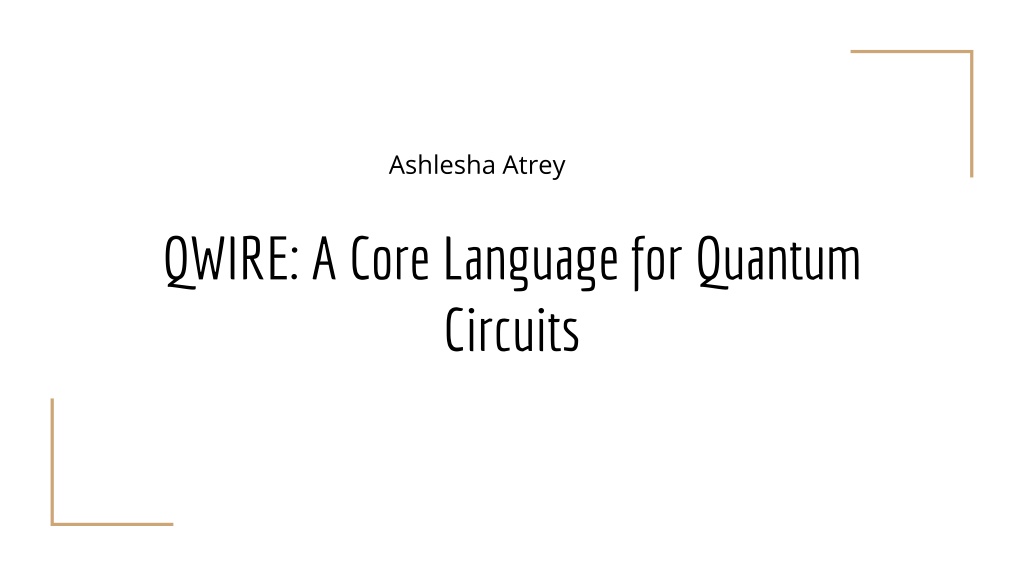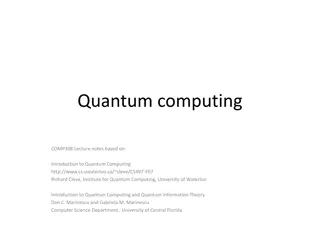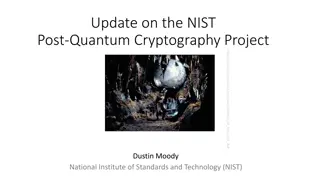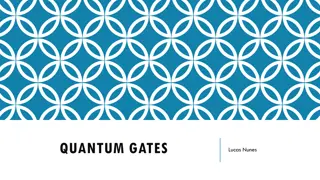Exploring QWIRE: A Language for Quantum Circuits
Delve into the details of QWIRE, a core language for quantum circuits, designed for safety, type-safety, and expressiveness. Discover the reasons for the success of the circuit model, the QRAM model, and the importance of type safety languages. Learn about the separation of classical and quantum computation within QWIRE and its structured approach based on the QRAM model.
Download Presentation

Please find below an Image/Link to download the presentation.
The content on the website is provided AS IS for your information and personal use only. It may not be sold, licensed, or shared on other websites without obtaining consent from the author. Download presentation by click this link. If you encounter any issues during the download, it is possible that the publisher has removed the file from their server.
E N D
Presentation Transcript
Ashlesha Atrey QWIRE: A Core Language for Quantum Circuits
Why is circuit model so successful? Low level of abstraction Qubits are unintuitive from a classical perspective Not much progress in conditionals and recursions
QRAM model Embedded language like Quipper, LIQUi|>, Q language, Quanum IO Monad
QRAM Model : QWIRE QWIRE design: Separation of classical computation in host language from quantum computation in the circuit language Syntactically separates quantum data inside circuits from classical data, and treats these two syntactic fragments as distinct languages. We need correctness, as they already are expensive and error prone
Type safety languages Ensure Well formed circuit dont get stuck Semantics for programs in terms of quantum mechanics Selinger s QPL language (Selinger 2004) quantum lambda calculus (Selinger and Valiron 2009) QML (Altenkirch and Grattage 2005), ProtoQuipper (Ross 2015). However, these are toy languages, not designed for implementation in a conventional programming environment
QWIRE: Type safety Keeping circuit language minimal and pushing the remaining infrastructure to host language Quipper and LIQUi|i do not cleanly separate embedded circuits from the host language Run time error can only occur in host language in QWIRE
Qwire A core language for quantum circuits Safe: - - - Linear types for wires Type safety & strong normalization Denotational semantics Expressive: - - Structured based on QRAM model Embedded in our favourite classical host language
Circuit Language Wire types: unit (has no data), a bit or qubit, or a tuple of wire types W ::= 1 | bit | qubit | W1 W2 Type judgment: ; C : W C is a circuit = w1 : W1, . . . , wn : Wn is a context of input wire names with their wire types = x1 :A1, . . . , xn : An is a context of host language variables with their host language types W is the output type of the circuit.
Examples: Gate A gate can be applied to a pattern of wires when permitted by the signature of the gate. The output of that gate is then decomposed by another pattern. The wires exiting the gate can then be used in the remainder of the circuit. Gate Model: G(W1, W2) for the set of gates with input W1 and output W2.
Examples: Compose We compose circuits by connecting the output of one circuit to the input wires of another. This operation differs from sequential composition in that the second circuit may have additional inputs.
Host Language: HOST The classical computer communicates with the quantum computer by sending it instructions that is, circuits in QWIRE. For each wire type there is a corresponding classical type for example, a host-level boolean might correspond to the qubit and bit wire types, and tensor wire types correspond to pairs.
Types of Hosts Types of Hosts: A ::= | Unit | Bool | A A | Circ(W1, W2)
Typing rules for QWIRE OUTPUT GATE COMPOSE LIFT UNBOX BOX
Boxes The type Circ(W1, W2) is a wrapper around QWIRE circuits of the form ; C : W2, where the wires in come from a pattern destructing the input type W1.
Communication: Dynamic and static lifting Quantum computer communicating with classical computer ; C :bit run C :Bool Wire Types to classical types: |bit| = Bool |qubit| = Bool |1| = Unit |W1 W2| = |W1| |W2|
Dynamic Lifting: communicate with classical x lift p; C to mean that the wires in p are measured, lifted to the classical computer as the host variable x, and used to compute the circuit C
Circuit Normalization Circuits in QWIRE represent instructions to be executed on a quantum computer: either apply a particular gate, or request a dynamic lifting operation. Eliminate unboxing and composition Two rules: - - Operate only on bit and qubit - concrete circuit Consists only of gate applications, outputs, and dynamic lifting operations - Normal circuit
Advantages of QWIRE: Interface to circuit is minimal Host language is extensible, since changes to host language dont induce changes to the circuit language Relationship between circuit language and host language can be easily axiomatized Every circuit can be promoted to the host language via a box operator, and then unboxed to be reused inside of other circuits.
In paper Operational semantics of circuit - Proof of type safety - Progress and preservation threomes Proof of strong normalization - Denotational semantics: proof of soundness Dependently typed circuits
Denotational Semantic Quantum system describe as density matrix W1 to W2 interpreted as a superoperator mapping density matrices corresponding to W1 to density matrices corresponding to W Measure
Dependent Types Circuit with n inputs and n outputs Types can depend on terms, but only terms of classical (non-linear) type
Summary Minimal and highly modular core language - - 5 commands with two eliminated using Normalization Not attached to any specific core language Uses linear types to enforce no-cloning Safe, small circuit level language
Discussion Parametric Operators on Circuits Automatic generation of Quantum Oracles Scalability Quantum Data Types
THANK YOU! Questions?
References QWIRE: a core language for quantum circuits. Jennifer Paykin, Robert Rand, Steve Zdancewic. POPL'17.























